Symphysodon aequifasciatus
Discus
Classification
Order: Perciformes Family: Cichlidae
Distribution
The natural range of this species extends down the Rio Solimões and along the main Amazon river, between the Rio Putamayo in Colombia and Peru as far as the Rio Tocantins drainage in Brazil. Introduced populations also exist in the neighbouring countries of Guyana and Suriname.
Habitat
It’s not often seen in the main river channels, being mostly found in slow-moving tributaries and forest pools. Here it lives in schools in deep, sheltered areas around tree roots and rocks.
Maximum Standard Length
The maximum size reported for wild Discus is around 14cm (6″). It is however claimed that Discus can actually reach 9″ in aquaria through a stringent regime of frequent, large water changes during the most important growth periods. See “Notes” for more information.
Aquarium SizeTop ↑
Although Discus only grow to around 6″, they can grow to be as tall as they are long. A breeding pair should have plenty of space both horizontally and vertically, so a tank around 48″ x 18″ x 18″ (120cm x 45cm x 45cm) – 255 litres is recommended for a few juvenile fish or a pair of breeding adults.
Maintenance
Many Discus fanatics choose to go down the heavily planted route which can be particularly beneficial to Symphysodon aequifasciatus due to the amount of cover afforded by such a setup. Discus are very shy, skittish fish and require as much cover as possible to feel comfortable.
Water Conditions
Diet
Wild fish feed mainly on zoplankton, insects and other small invertebrates.

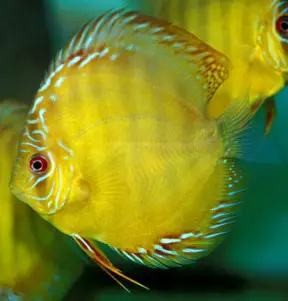
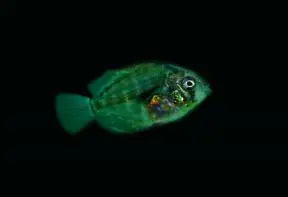
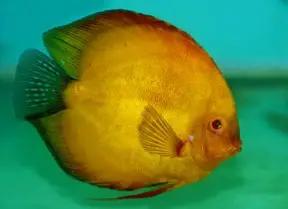
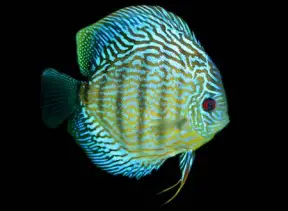
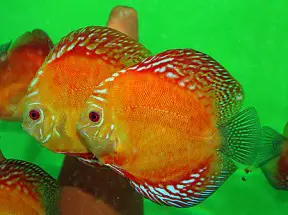
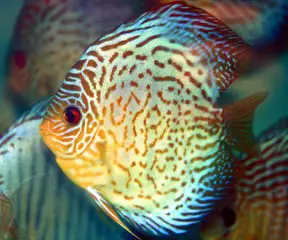
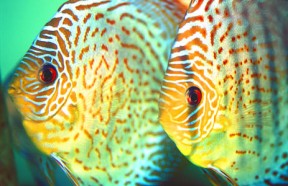


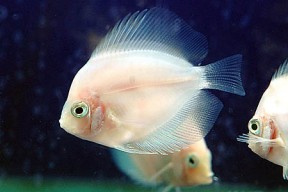

June 5th, 2012 at 3:27 pm
Someone filled this up after a bit of Jubilee celebration…Several sections show the same text “Wild fish feed mainly on zoplankton, insects and other small invertebrates”. When can we expect the full text?
Tks.
June 6th, 2012 at 8:39 am
Have fixed the issue but this profile hasn’t been touched for several years and like many in the database requires proper editing. With so much still to do no idea exactly when this is likely to happen, I’m afraid.
December 13th, 2012 at 11:09 am
Discus prefer a slightly acidic PH, A PH of between 6.0 and 6.5 is okay for them although Wild discus are generally harder to keep in an aquarium environment. Young discus need frequent water changes, I would suggest at the minimum 30% every 2 days although once a day is obviously better, once they reach adult stage 30% every second day is okay but again every day is better. Discus like to have a nice large root to swim around, it makes them feel at ease as they are a shy fish.
For feeding discus many people like to make their own frozen food as a part of their diet, with a mixture of beef heart, shrimp, cod and vegetables, something like 70% beef heart (remove the white sinew from the beef heart), 15% cod, 10% shrimp and 5% peas would be good, you can find many other recipes online, just put it in the blender, compact it into a flat slab and freeze it, then break off chunks for feeding as needed. Discus need a wide variety of foods such as pellets and flake foods and will eat a good variety too, they are not too picky, remember to give them a varied diet, feeding small amounts a good few times a day. Don’t feed them more than they can eat in about 30 seconds, most food packets say 2-3 minutes but I think this is too much, a fishes stomach is only about the size of it’s eyes.
February 5th, 2013 at 3:23 pm
To Alan. The diet You wrote about is bollocks It’s a strange thing that rarely anybody thinks about what actually feeding the meet of warm-blooded animals does to the (most of) fish. In case od S. sp the results of such a diet means an outstanding growth, coloration.. Everything bigger and better than in the nature. Well.. it does sound strange, doesn’t it? In the Amazon, where they can eat what they want and need they are smaller, yet they are not underfed.
It’s a strange thing that rarely anybody thinks about what actually feeding the meet of warm-blooded animals does to the (most of) fish. In case od S. sp the results of such a diet means an outstanding growth, coloration.. Everything bigger and better than in the nature. Well.. it does sound strange, doesn’t it? In the Amazon, where they can eat what they want and need they are smaller, yet they are not underfed.
Another thing, in the natural habitat discus is a rather hardy species. It does well avoiding any problems with parasites. Why is that?
The DIET of course! Becouse DISCUS IS MAINLY A HERBIVORE SPECIES!
How so?! What are You talking abou! Blasphemy! Burn him into a crisp!
There were many dissections of discus in the wild. For polish speakers I hereby present the link:
http://krytykaakwarystyczna.wordpress.com/zywienie-ryb-moze-wreszcie-niektorzy-zrozumieja-ze-czyli-czym-odzywiaja-sie-przedstawiciele-rodzaju-symphysodon-w-naturze/
The unprocessed food was analised by Crampton, and the result is, that at the wet season 77% of the food was detrytus and plant matter, 5% were decapods, 10% Chironimidae larvae, 8% were composed of wood matter, bugs and Crustacea. In the dry season, the balance drifts towards bugs and crustacea (only 55% were composed ef the detrytus/plant matter).
Their intestines are not built for devouring the flesh of the warm-blooded animals. It’s typical for plant eaters.
What is the CORRECT FOOD ?
-spirulina
-spinach
-peas
-other vegetables
-shrimps
-glassworm
-bloodworm
-krill
No fish meat was ever found in the stomach of a wild discus.
So it’s NOT RECOMMENDED to give them:
-fish
And it WRONG to give them:
-hearts of warm-blooded animals
-or any parts of warm blooded animals.
It makes them sick, destoys their organs, especially livers. The wrong diet is the cause of the discus beeing considered as a hard-to-breed fish. It’s easy! Bit you need to mind their normal diet! The one that they were constantly exposed since thousands of years.
September 17th, 2013 at 8:57 pm
To Sverting. LMAO, well said. I couldn’t agree with you more.
March 14th, 2014 at 2:35 am
Hey guys,
I’ve a friend that’s been keeping Discus for several months now (probably going on 6+). Over the months, she’s had the unfortunate task of cleaning her tank every few days or so, due to excessive slime (from the Discus shedding their slime coat) coating her plants, tank walls, etc. It became unsightly and was of brownish color.
When I tried to search for this online, I couldn’t find anything about Discus “shedding” their slime coat. In fact, the only thing I could find was that an irritant in the water could make fish shed their slime coat, in addition to Discus fry feeding off the parent’s coat in the beginning stages of life.
All I know is that fish losing their slime coat is usually a bad thing and should be a sign of some disorder or problem in the tank. Can you confirm if this is normal for Discus?
Thanks very much,
Kevin
April 21st, 2015 at 10:27 am
I used to breed discus. I had the experience that in water with a ph higher than 5.5 less eggs would develop. I created soft water using a reverse osmosis filter, I ensured the low ph was maintained with phosphoric acid. I used an under the tanks trickle filter, and I could do water changes (30% 2 times a week) without disturbing the fish. The size of the breeding tanks (I had eight of them) was 50 cm x 50 cm x 50 cm (125 liter) and I had flowerpot type cones in the center of the tank.
Before I started breeding I tended to keep them in a tank with lots of hiding places. I learned however, that when there are plenty of hiding places the fish stay more skittish. The breeding pais I kept in a bare tank lost their skittishness quite fast, when they learned that not every movement is a threat of danger.
May 4th, 2019 at 8:41 pm
Sverting,
Thank you for the insight.I will be adding more brine shrimp, mysis shrimp and spiralina algae,with blood worms to my wild Discus diet.My domestic seem to have evolved to do fine on beef heart yet do like blood worms.So have they evolved differing water parameters according to specific breeders.German,Asian American,ect..
May 4th, 2019 at 8:42 pm
Sverting,
Thank you for the insight.I will be adding more brine shrimp, mysis shrimp and spiralina algae,with blood worms to my wild Discus diet.My domestic seem to have evolved to do fine on beef hearts.So have they evolved differing water parameters according to specific breeders.German,Asian American,ect..